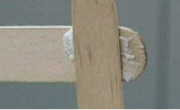본 연구의 목적은 서로 다른 종류의 접착시스템과 법랑질보호제 등이 설측 브라켓의 인장강도에 영향을 미치는지 알아보는데 있다. 75개의 발치된 하악 전치를 5개의 그룹으로 임의로 나눈 ...
http://chineseinput.net/에서 pinyin(병음)방식으로 중국어를 변환할 수 있습니다.
변환된 중국어를 복사하여 사용하시면 됩니다.
- 中文 을 입력하시려면 zhongwen을 입력하시고 space를누르시면됩니다.
- 北京 을 입력하시려면 beijing을 입력하시고 space를 누르시면 됩니다.



하악 전치 설측면에 대한 다양한 접착시스템의 접착강도 = Bond strength of different bonding systems to the lingual surface enamel of mandibular incisors
한글로보기https://www.riss.kr/link?id=A105525437
- 저자
- 발행기관
- 학술지명
- 권호사항
-
발행연도
2010
-
작성언어
-
- 주제어
-
KDC
515
-
등재정보
SCOPUS,SCIE,KCI등재
-
자료형태
학술저널
- 발행기관 URL
-
수록면
260-266(7쪽)
-
비고
학회 요청에 의해 무료로 제공
- 제공처
-
0
상세조회 -
0
다운로드
부가정보
국문 초록 (Abstract)
본 연구의 목적은 서로 다른 종류의 접착시스템과 법랑질보호제 등이 설측 브라켓의 인장강도에 영향을 미치는지 알아보는데 있다. 75개의 발치된 하악 전치를 5개의 그룹으로 임의로 나눈 후 설측 브라켓을 부착하였다. Group 1은 Transbond XT를, Group 2는 Transbond XT와 함께 불소 유리레진(Ortho-coat)을 Group 3는 Transbond XT와 Chlorohexidine varnish (Cervitec Plus)를 Group 4는 광중합 접착제(Aegis Ortho)를 Group 5는 antimicrobial self-etching primer(Clearfil Protect Bond)을 사용하였다. 불소유리 레진이나 Chlorohexidine varnish의 사용유무는 접착력에 영향을 미치지 못하였다. Group 5이 다른 그룹에 비해 접착력과 접착제 잔류지수(adhesive remnant index, ARI)가 통계적으로 유의하게 높았다 (p < 0.001). 법랑질 보호제 적용 시 설측 브라켓의 접착력에 부정적인 영향을 미치지 못하였다. 이상의 결과로 이번에 사용한 제품들은 설측 교정치료 기간 동안 환자의 구강위생을 개선시킬 수 있어 환자와 술자에게 도움을 줄 수 있을 것이다. 그러나 에나멜 층이 얇은 경우 Clearfil Protect Bond의 과도한 접착강도에 대해 고려해야 할 것이다.
다국어 초록 (Multilingual Abstract)
Objective: The aim of this study was to determine whether different types of adhesive systems and enamel-protective agents will affect the tensile bond strength of lingual brackets. Methods: A total of 75 extracted mandibular incisors were randomly di...
Objective: The aim of this study was to determine whether different types of adhesive systems and enamel-protective agents will affect the tensile bond strength of lingual brackets. Methods: A total of 75 extracted mandibular incisors were randomly divided into 5 groups and lingual brackets were bonded. Group 1 specimens received Transbond XT (3M Unitek, Monrovia, CA, USA), Group 2 required the application of a fluoride-releasing resin (Ortho-coat, Pulpdent, Watertown, MA, USA) with Transbond XT, Group 3 specimens received a chlorhexidine varnish (Cervitec Plus, Ivoclar Vivadent, Schaan, Lichtenstein) with Transbond XT. In Group 4, a light-cured orthodontic adhesive (Aegis Ortho, Bosworth, Skokie, USA) was applied and in Group 5, an antimicrobial self-etching primer (Clearfil Protect Bond, Kuraray, Osaka, Japan) was used. Results: There were no significant differences in bond strength whether fluoride-releasing resin or chlorhexidine varnish were used or not. Group 5 had significantly higher bond strength and adhesive remnant index (ARI) values than other groups (p < 0.001). The application of enamel-protective products did not have an adverse affect on the bond strength of lingual brackets. Conclusions: These products might provide benefits both for the patient and the clinician, by supporting the oral hygiene during lingual orthodontic treatment. The higher ARI score may be beneficial for Clearfil Protect Bond but its excessive bond strength should be considered in clinical practice, especially where the enamel is thin.
동일학술지(권/호) 다른 논문
-
치간 삭제 후 불소 또는 수산화인회석 도포 시 재광화 및 탈회억제에 관한 연구
- 대한치과교정학회
- 홍현실
- 2010
- SCOPUS,SCIE,KCI등재
-
저신장 소아에서 성장호르몬 치료가 두개안면필 성장에 미치는 영향
- 대한치과교정학회
- 정성호
- 2010
- SCOPUS,SCIE,KCI등재
-
Severe bidentoalveolar protrusion treated with lingual Biocreative therapy using palatal miniplate
- 대한치과교정학회
- Chung, Kyu-Rhim
- 2010
- SCOPUS,SCIE,KCI등재
-
- 대한치과교정학회
- Metin Nur
- 2010
- SCOPUS,SCIE,KCI등재




 스콜라
스콜라






